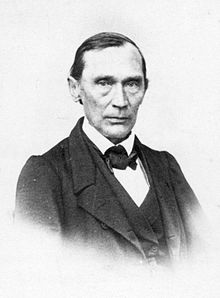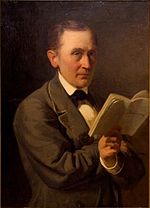Friedrich Reinhold Kreutzwald
You can help expand this article with text translated from the corresponding article in Estonian. (April 2015) Click [show] for important translation instructions.
|
Friedrich Reinhold Kreutzwald | |
|---|---|
 | |
| Born | 26 December [O.S. 14 December] 1803 |
| Died | 25 August [O.S. 13 August] 1882 (aged 78) Tartu (Dorpat), Governorate of Livonia, Russian Empire |
| Resting place | Raadi cemetery |
| Occupation | Writer |
| Movement | Estonian national awakening |
Friedrich Reinhold Kreutzwald (26 December [O.S. 14 December] 1803 – 25 August [O.S. 13 August] 1882) was an Estonian writer and the author of Estonian national epic Kalevipoeg.
Life[edit]


Friedrich Reinhold Kreutzwald was born to Estonian parents[1] at the Jõepere (Jömper) estate, Governorate of Estonia (then part of Russian Empire). His father Juhan worked as a shoemaker and granary keeper and his mother Anne was a chambermaid. The family was able to send their son to school at the Rakvere (Wesenberg) district school.
In 1820, he graduated from secondary school in Tartu (Dorpat), and started working as an elementary school teacher. In 1833, Kreutzwald graduated from the Faculty of Medicine at the Imperial University of Dorpat.

Kreutzwald married Marie Elisabeth Saedler on 18 August the same year. From 1833 to 1877, he worked as the municipal physician in Võru (Werro).[2] He was the member of many scientific societies in Europe and received honorary doctorates from several universities.
Works[edit]

Kreutzwald is the author of several moralistic folk books, most of them translated into German: Plague of Wine 1840, The World and Some Things One Can Find in It 1848–49, Reynard the Fox 1850, and Wise Men of Gotham 1857. He wrote many works based on Estonian folklore, such as Old Estonian Fairy-Tales (1866), collections of verses, and the poem Lembitu (1885), published after his death.
Kreutzwald's magnum opus was the national epic Kalevipoeg (Kalev's Son),[3] which was composed using material initially gathered by his friend Friedrich Robert Faehlmann (1798–1850). In 1839, Faehlmann had read a paper at the Learned Estonian Society about the legends of Kalevipoeg and sketched the plot for a national romantic epic poem.[4] In 1850, after Faehlmann's death, Kreutzwald started writing the poem, interpreting it as the reconstruction of an ancient oral epic. He collected oral stories and wove them together into a unified whole.
The first version of Kalevipoeg (1853; 13,817 verses) could not be printed due to censorship.[5] The second, thoroughly revised version (19,087 verses) was published in 1857–1861 in sequels as an academic publication in the Proceedings of the Learned Estonian Society. The publication included a translation into German. In 1862, the third, slightly abridged version (19,023 verses) was published. This edition of the book was intended for the general Estonian-speaking public, and printed in Kuopio, Grand Duchy of Finland (the then neighbouring province of the Russian Empire).
As Kalevipoeg became a bestseller, Kreutzwald soon reached the status of a symbolic leader of the mid-19th century Estonian national awakening. At the time, he was also widely considered a paragon for younger Estonian-speaking intellectuals.
See also[edit]
References[edit]
External links[edit]
- Works by Friedrich Reinhold Kreutzwald at Project Gutenberg
- Works by or about Friedrich Reinhold Kreutzwald at Internet Archive
- Works by Friedrich Reinhold Kreutzwald at LibriVox (public domain audiobooks)

- 1803 births
- 1882 deaths
- People from Kadrina Parish
- People from the Governorate of Estonia
- Estonian physicians
- Estonian male poets
- Epic poets
- Collectors of fairy tales
- Estonian folk-song collectors
- 19th-century Estonian painters
- 19th-century Estonian male artists
- 19th-century Estonian poets
- 19th-century male writers
- Burials at Raadi cemetery
- Physicians from the Russian Empire
- 19th-century musicologists
